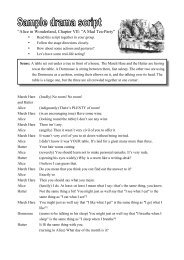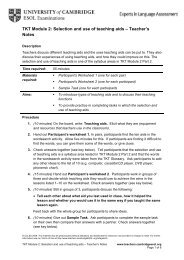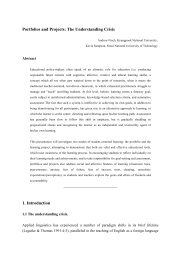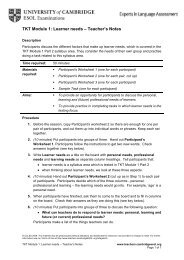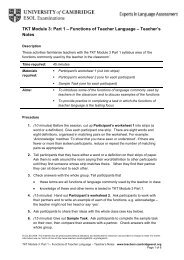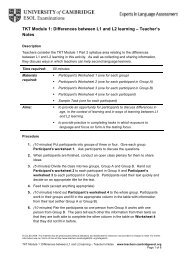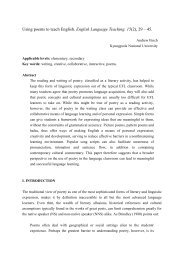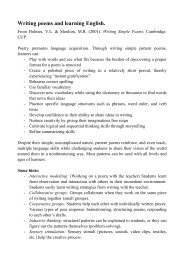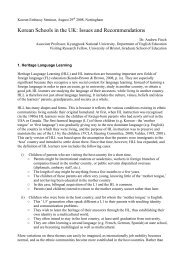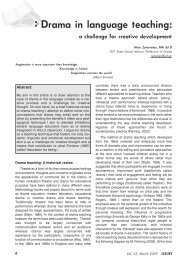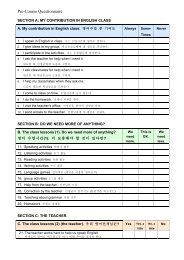Classroom Activity - Finchpark
Classroom Activity - Finchpark
Classroom Activity - Finchpark
You also want an ePaper? Increase the reach of your titles
YUMPU automatically turns print PDFs into web optimized ePapers that Google loves.
4. Explain that this syllabus area also tests candidates on their knowledge of ‘the designand purpose of a range of comprehension and production tasks and activities’. Askparticipants:• What do comprehension activities do? (test or develop listening or readingskills and subskills)• What do production tasks and activities do? (provide opportunities forlearners to practise and extend their productive skills, i.e. speaking and writing)5. (10 minutes) Hand out Participant’s worksheet 2. Participants work with theirpartners and choose the correct name for each task from the list at the top of theworksheet. Check answers together (see key below).6. (10 minutes) Refer participants again to the first activity on Participant’s worksheet2 – a survey. Ask:• Is a survey used for testing or developing comprehension or forpractising and extending productive skills? (practising and extendingproductive skills)• Which productive skills? (speaking)• Is this a controlled practice activity, a less controlled practice activity or afree practice activity? That is, how much choice do students have in thelanguage they use? (It depends on the survey. They can be designed topractice specific language (controlled practice or less controlled practice), orthey could be designed to allow students to develop oral fluency (free practice).Sum up by confirming that surveys are used to practise or extend speaking skills andcan be used for controlled practice, less controlled practice or free practice.7. Participants work in pairs again and refer to Exercise 2 on Participant’s worksheet2. Point out that some of the activities may be designed for more than one purpose.Check answers together (see key below).8. (15 minutes) Ask participants to think about lessons they have had and about howactivities can be linked in a lesson. Point out that the types of activities, the ways theactivities are used and how they follow each other in the lesson depends on theapproach, and the ‘framework’ or procedures that the approach uses.9. Participants work in groups of three. Give out Participant’s worksheet 3 Exercise1, and ask participants to fold the worksheet in half along the dotted line (they shouldnot look at Exercise 2 yet). Participants discuss the frameworks/procedures and theactivities that are used for these approaches. Allow 5 minutes for this discussion.10. Participants now unfold Participant’s worksheet 3 and look at Exercise 2. Theycontinue to work in their groups of three and decide which of the approaches go witheach of the frameworks in Exercise 2. Give out Participant’s worksheet 4 forparticipants to check their answers.11. (10 minutes) Give out the Sample Task. Participants complete the task on their ownthen compare their answers with a partner. Check answers together (see key below).© UCLES 2009. This material may be photocopied (without alteration) and distributed for classroom use provided no charge is made. For furtherinformation see our Terms of Use at http://www.teachers.cambridgeESOL.org/ts/legalinfoTKT Module 1: Types of activities and tasks for language and skills development – Teacher’s Noteswww.teachers.cambridgeesol.orgPage 2 of 9



